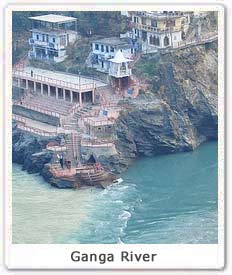Ganga is the sacred river of India. Ganga originated from the Gangotri Glacier , which is located in the western Himalayas. It is one of the major rivers of India, which is approximately 1557 miles long. It flows into the eastward directions and empties into the Bay of Bengal.
 History
:
History
: The history of the Ganga river is old as the Indian civilization. For the years Ganga has been the only spectator of all changes that have shaped the Indian history, culture and its people. It has seen the rise and fall of many empires. It has been the prime witness of all the religions especially Hinduism, Buddhism, Islam, Christianity and Jainism.
There are many stories as to how river Ganga came down from haven to earth. According to the Indian ancient books, King Sagar had sixty thousand sons who were burnt to ashes due to the anger of saint Kapil Muni. They blamed that the saint has stolen a horse of the ritual yagna of King Sagar. King Sagar took suggestion from various saints regarding the salvations of his sons. They all suggested that if the Holy Ganga is brought from the haven and the ashes of his sons were dipped in it, their souls will definitely achieve nirvana or moksha. King Sagar requested his son Bhagirath to worship Lord Brahma. He does the same for many years. When Brahmaji was pleased, he asked him to release Ganga from his Kamandal and let it flow on the earth. Brahma told that he would do as such but the earth will not be able to tolerate the extreme velocity of Ganga. That is the reason Lord Shiva received Ganga on his head. Lord Shiva did so but somehow Ganga got stuck in his hair. King again worshiped Shiva to release Ganga from his hair. Since than Ganga has been flowing on earth and is worshiped by billions.
Religious Significance :
Ganga is regarded as the holy river of India. According to the Hindu beliefs a dip in the Ganga water can wash away all the sins. Thousand of people spend the last days of their life on the bank of the river. Ganga is regarded as the Goddess and is worshiped among the Hindus. Ganga Devi is one of the two daughters of Meru (the Himalayas), the other one is Uma (the consort of Shiva). Every day the arti (prayer) is done on the bank of the river to pay homage to the Goddess Ganga. Many people in India call Ganga as Ganga Ma. Ganga finds mention in the ancient Hindu scriptures called Rig Veda.
Economy :
Ganga has been serving million people for the centuries. Its fertile soil is good for the agricultural purpose. It serves as the source of irrigation to the large area. Some of the crops that can be cultivated along the river includes rice, sesame, sugarcane, millets, wheat, potatoes, sugarcane, jute and seeds. Ganga has been the source of drinking, bathing and baptism.
Adventure :
Ganges have been the ultimate rafting site in India. The magic of white water rafting at the Ganges especially in Rishikesh is beyond one's imagination. Besides rafting you can also try out various other water sports in its water. Apart from the water sports Ganga holds the great wildlife. It is the home to number of resident and migratory birds.






